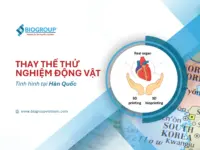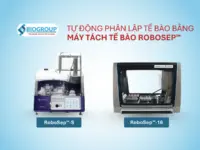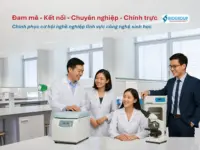Potential of ocular extracellular vesicles & exosomes in ophthalmology
The workshop, organized by the National Eye Institute (NEI), focused on evaluating the current status, identifying challenges, and addressing the needs in ocular extracellular vesicle (EV) research. The workshop brought together 20 experts from various fields to discuss EV biology and the potential applications of EVs in diagnosing and treating eye diseases.
This workshop is a key activity in implementing NEI’s “Vision for the Future (2021–2025)” strategic plan, which prioritizes EV research in the field of regenerative medicine. This article presents insights from the workshop, highlighting new opportunities and the potential of ocular extracellular vesicle research in improving eye health. It also introduces an exosome isolation solution that supports ocular extracellular vesicle research.
Contents
ToggleWhat are ocular extracellular vesicles?
Ocular extracellular vesicles (EVs) are heterogeneous, nano-sized particles encased in lipid membranes. These include exosomes, ectosomes, microvesicles, and apoptotic bodies. They are released by cells and play a role in intercellular communication through various components such as RNA, DNA, proteins, and lipids. Ocular extracellular vesicles are considered potential biomarkers and a non-cellular method supporting regenerative medicine, particularly promising in treating eye diseases. However, the diagnostic and therapeutic potential of ocular extracellular vesicles has not been fully explored. Basic understanding of EV biology in the visual system is still in its infancy.
The eye has unique characteristics such as its compact size, specialized immune function with the blood-eye barrier, its biological fluids, and the ability to deliver drugs locally. Vision research has always led technological advancements, such as optical coherence tomography (OCT), gene therapy, and intravitreal anti-VEGF therapy. Therefore, vision research has great potential to lead advancements in ocular extracellular vesicle research, opening up unique opportunities for exploration and progress.
The National Eye Institute (NEI) has made ocular extracellular vesicle (EV) research a top priority in regenerative medicine, one of the seven key focuses of its “Vision for the Future (2021–2025)” strategic plan.
Opportunities and challenges in ocular extracellular vesicle research
During the discussion, it was noted that research on ocular extracellular vesicles lags behind other fields, as evidenced by the number of published papers and clinical trials.
Tears are a readily accessible biological fluid that provides valuable biological information related to many eye diseases, including dry eye disease, keratoconjunctivitis, Sjögren’s syndrome, Meibomian gland dysfunction, and ocular graft versus host disease (OGVHD). Recent studies have shown that tears contain a large number of molecules, including lipids, electrolytes, proteins, peptides, and small molecular metabolites. These come from various sources, including lacrimal glands, Meibomian glands, goblet cells, epithelial cells, and nerves on the surface of the eye.
However, there are still challenges in researching ocular extracellular vesicles in tears and other ocular biological fluids, such as the vitreous body and aqueous humor.
These challenges include::
- Limited sample volume leads to low EV concentrations in discovery studies.
- Lack of understanding of specific biomarkers identifying the origin of EVs from different eye cells and tissues.
- Uncertainty about the changing function of EVs in eye diseases.
- The degree to which circulating EVs are related to eye diseases remains unclear.
To ensure cell and gene therapies meet high safety and quality standards, transitioning to CD/AOF materials is no longer optional but essential.
Tools and methods for ocular extracellular vesicle research
Table 1: Tools and methods used for EV isolation (See appendix)
|
Method |
Efficiency |
Purity |
Optimal volume |
Biological activity |
Analysis |
|
DUC |
++ |
++ |
M – L |
++ |
EM, NTA, WB, FC/dFC |
|
PEG |
+++ |
+ |
S – L |
+ |
Requires secondary isolation method |
|
DGUC |
+ |
+++ |
M – L |
++ |
EM, WB, NTA, MS, NGS, LA, FC/dFC |
|
IAC |
++ |
++/+++ |
S |
+ |
WB, MS, NGS, LA |
|
SEC |
+/++ |
++ |
S – M |
+++ |
EM, NTA, WB, MS, NGS, LA, FC/dFC |
|
TFF |
++ |
++ |
L |
+++ |
EM, NTA, WB, MS, NGS, LAFC/dFC |
|
HiMEX |
+ |
++/+++ |
S |
+ |
N/A; combines isolation and analysis |
|
EXODUS |
+++ |
+++ |
S – M – L |
+++ |
EM, NTA, WB, FC |
Where different isolation methods influence biological activity due to their effect on exosome membrane integrity.
EXODUS automatic exosome isolation solution in ophthalmology
EXODUS uses advanced technology to extract exosomes based on a dual-layer nano-filtration system integrated with periodic negative pressure oscillation (NPO) and double-coupled harmonic oscillations (HO). Contaminants in the sample, such as free nucleic acids and proteins, can be quickly removed. Exosomes are retained by the nano-pores, which helps to purify and enrich the exosomes.
The diagnostic and therapeutic potential of ocular extracellular vesicles has been emphasized thanks to technological advancements and multidisciplinary research. EVs from stem cells and other cell types show anti-inflammatory, regenerative, neuroprotective, and life-supporting properties. Using molecular biology techniques, such as modifying surface markers or loading EVs with drugs, opens new prospects for treating eye diseases.
However, limited understanding of the role of ocular extracellular vesicles in eye diseases, along with technological barriers like isolation, characterization, and in vivo tracking, also hinders clinical applications. These gaps create opportunities for basic research and technology development. The convergence of EV technology and vision research opens up breakthrough potential, driven by interdisciplinary collaboration among scientists from various fields.
Related articles: “Exosome isolation solutions for research and regenerative medicine”
Related articles: “EXODUS T-2800 & H-600 | Automatic exosome isolation systems”
Contact for exosome isolation solutions consultation:
- Website: https://biogroupvietnam.com/public/lien-he
- Hotline: +84 963 621 421
- Email: info@biogroupvietnam.vn
Appendix
Abbreviations for analysis methods in Table 1:
DUC – differential ultracentrifugation
DGUC – density gradient ultracentrifugation
EM – electron microscopy
EXODUS – exosome detection via the ultrafast-isolation system
FC/dFC – (digital) Flow Cytometry
HiMEX – high-throughput magneto-electrochemical extracellular vesicles system
IAC – immunoaffinity capture
LA – lipidomic analysis
MS – mass spectrometry
NGS – next-generation sequencing
NTA – nanoparticle tracking analysis
PEG – polyethylene glycol precipitation
SEC – size exclusion chromatography
TFF – tangential flow filtration
WB – western blotting
References
- National Eye Institute. (n.d.). Extracellular vesicle workshop. National Eye Institute. https://www.nei.nih.gov/about/goals-and-accomplishments/nei-research-initiatives/regenerative-medicine/extracellular-vesicle-workshop
- Chen, Y., Zhu, Q., Cheng, L., Wang, Y., Li, M., Yang, Q., … & Liu, F. (2021). Exosome detection via the ultrafast-isolation system: EXODUS. Nature Methods, 18(2), 212-218. https://www.nature.com/articles/s41592-020-01034-x
- Théry, C., Witwer, K. W., Aikawa, E., Alcaraz, M. J., Anderson, J. D., Andriantsitohaina, R., … & Zuba-Surma, E. K. (2018). Minimal information for studies of extracellular vesicles 2018 (MISEV2018): A position statement of the International Society for Extracellular Vesicles and update of the MISEV2014 guidelines. Journal of Extracellular Vesicles, 7(1), 1535750. https://doi.org/10.1080/20013078.2018.1535750
Categories
- Blog (53)
- New Products & Technologies (42)
- News (41)
- Recruitment (7)
- Training & Webinar (27)
- Virtual Booth (1)




